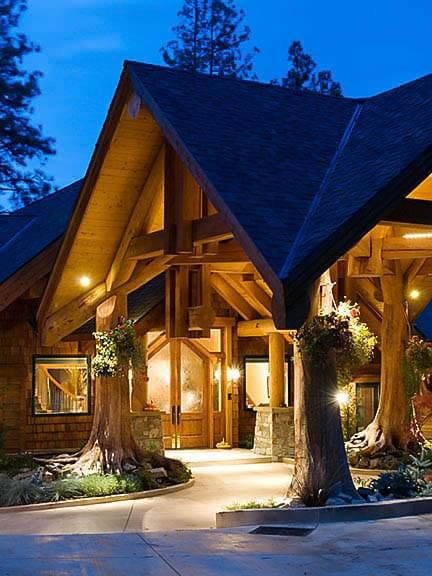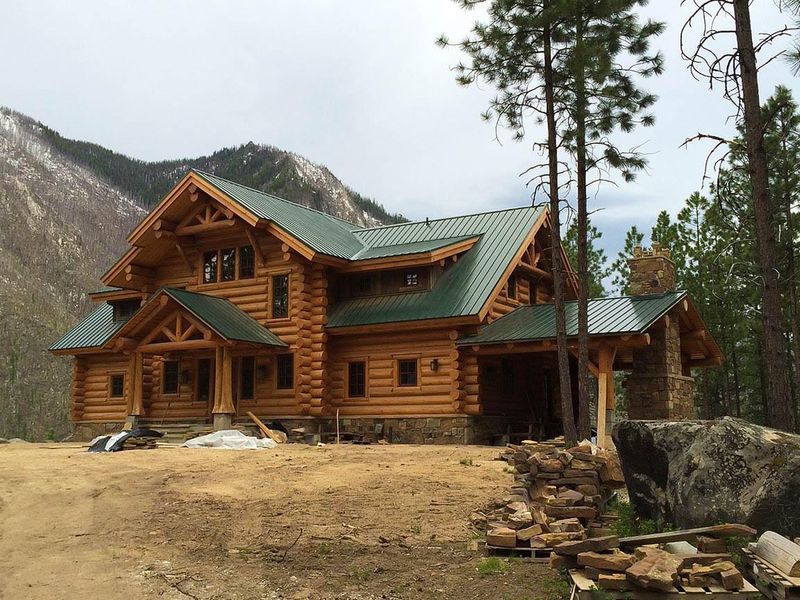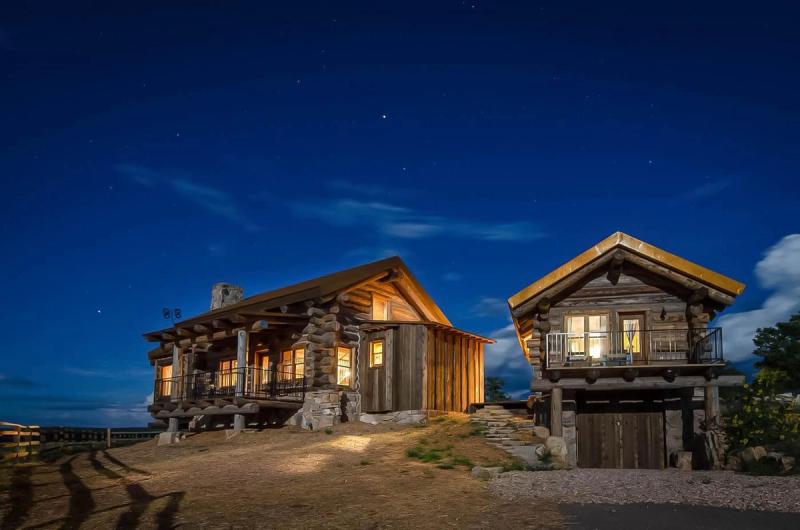Crafting the perfect log cabin roof enhances the aesthetic appeal of your rustic retreat and plays an essential part in its longevity and durability. Choosing the right materials, such as prebuilt log-wall panels and thermal efficient roof construction, and maintaining the log cabin roof can make all the difference. Each material offers unique benefits and challenges, whether it’s the charm of asphalt shingles, the robustness of metal roofing, or the elegance of tile.
Regular inspections and prompt repairs are necessary to extend the life of your log cabin roof. Spotting early signs of damage, such as missing shingles or cracked tiles, can save homeowners from costly repairs. Moreover, keeping the log cabin roof clean from debris further shields it from potential harm.
For those who might not be as handy or prefer professional expertise, hiring a skilled roofing contractor can ensure that your log cabin roof is in top condition. They bring the necessary experience and knowledge to handle any roofing challenges effectively.
Distinguishing Roofing Types: Heavyweight vs. Lightweight Roofs
When considering roofing options for log cabin homes, the choice between lightweight and heavyweight roofs often revolves around factors such as structural integrity and aesthetic appeal. Lightweight roofing materials like metal or composite shingles are particularly well-suited for log cabins due to their ease of installation and compatibility with the relatively simpler structures of these homes. These materials offer the advantage of reducing the overall load on the cabin's structure, which is especially important for log cabins built in remote or rugged areas where access to heavy construction equipment may be limited. Additionally, lightweight roofs can complement the rustic charm of log cabins while providing adequate protection against the elements, making them a practical and visually appealing choice for many cabin owners.

Conversely, some log cabin enthusiasts may prefer the timeless elegance and durability of heavyweight roofing materials such as natural slate or clay tiles. While these options may require a stronger foundation to support their weight, they offer unmatched longevity and aesthetic appeal that can enhance the character of a log cabin home. Heavyweight roofs provide excellent insulation, which can be advantageous in colder climates where maintaining a comfortable indoor temperature is crucial. Although the initial cost and installation complexity of heavyweight roofs may be higher compared to lightweight alternatives, their resilience against harsh weather conditions and minimal maintenance requirements make them a compelling choice for those seeking a traditional and enduring roofing solution for their log cabin retreat.
Key Materials Used in Cabin Roofing
Shingles: Asphalt and Architectural
Asphalt shingles represent a budget-friendly and popular choice for log cabin roofing, known for their cost-effectiveness and wide variety of color options. These shingles typically last between 15 to 30 years, making them a practical choice for many homeowners. They are readily available and simple to install, reducing roofing projects' overall cost.
Architectural shingles, a premium variant of asphalt shingles, offer enhanced durability and aesthetic appeal. Composed of two layers bonded with asphalt sealant, these shingles are thicker and create shadow lines that mimic the appearance of more expensive materials like slate or wood shakes. Although they cost 20-40% more than basic three-tab shingles, architectural shingles come with extended, sometimes lifetime, warranties due to their long-lasting nature.
Metal Roofs: Durability and Style
Metal roofing, a robust material choice for log cabins, excels in durability and longevity. Metal roofs can last up to 50 years or more in materials like aluminum and steel. They are particularly suitable for log cabins in areas prone to severe weather, as they withstand high winds, heavy snow, and rain without rusting or cracking. Metal roofs also offer a variety of styles and colors, allowing customization to fit any log cabin aesthetic, from modern to rustic.

The distinctive characteristic of standing seam metal roofs, with their raised interlocking seams, prevents water infiltration and adds to the roof's structural integrity. These roofs not only protect against the elements but also enhance the visual appeal of the log cabin, aligning with any design theme.
Natural Materials: Wood Shakes and Slate
Wood shakes are chosen for their natural beauty and ability to blend seamlessly into rustic surroundings. Each shake is unique, providing a distinct textured look that enhances the log cabin's natural appeal. However, wood shakes require regular maintenance to prevent decay and damage from insects or moisture.
Slate is another high-end roofing material that boasts incredible longevity and sturdiness. Its natural stone appearance adds elegance to any log cabin, elevating its overall aesthetic significantly. Slate roofs are fireproof and resistant to harsh weather conditions, making them an excellent investment for a lifetime roof. Because of their weight, installing a slate roof requires additional structural support, which can increase construction costs.
Each material offers distinctive benefits and aesthetics, allowing log cabin owners to customize their choices based on budget, climate, and personal style preferences. Selecting the right roofing material ensures the structure's longevity and enhances the cabin's visual appeal.
For additional options, visit Big Cabin for more information.
Choosing the Right Style for Log Cabin Roofs
Impact of Climate on Roof Selection
Selecting the appropriate roof style for a log cabin depends significantly on the climatic conditions where it is located. For instance, areas prone to heavy snowfall benefit from steeply pitched roofs, such as the gable style. While some snowfall can actually help insulate a home, too much snow can damage a lightweight roof. A gable design facilitates the shedding of snow, thus preventing damage from excessive load. In contrast, regions with frequent storms may require a more robust roofing solution, such as metal roofing, which offers resistance to high winds and is less likely to be damaged by falling debris.
Materials that reflect rather than absorb heat, like light-colored metal or tiles, are suitable for log cabins in the warmer summer months. These materials help maintain cooler indoor temperatures and reduce the burden on air conditioning systems.
Aesthetic Considerations
The choice of roof style can significantly improve the visual appeal of a log cabin, so aesthetics are an important consideration when choosing a roof. With its classic peak and symmetrical slopes, the gable roof adds a traditional charm to log cabins and maximizes the internal loft space. Alternatively, hip roofs present a more modern look with their sloping on all four sides, which can complement contemporary log cabin designs.

Materials also significantly influence the overall appearance. Wood shingles might offer a rustic feel that aligns with natural surroundings, whereas slate tiles provide an elegant, refined look. Moreover, green roofs can integrate log cabins seamlessly into their environment while offering additional insulation.
By carefully considering both climate impact and aesthetic implications, log cabin owners can select a functional and beautifully suited roof to their properties.
Maintenance and Longevity of Cabin Roofs
Regular Maintenance Tips
Homeowners should regularly maintain their log cabin roofs by conducting biannual inspections in spring and fall to prepare for extreme weather conditions. Key tasks include ensuring gutters and downspouts are clear of debris to prevent water damage, inspecting and replacing damaged shingles, removing moss or algae with a brush or installing metal strips to inhibit growth, trimming overhanging branches to decrease moisture and shade that encourage moss and algae, and checking seals and flashing around roof features for wear or damage. Regular upkeep helps extend the roof's lifespan and maintains its effectiveness against seasonal weather challenges.
Dealing with Common Issues: Leaks and Weather Damage
Leaks and weather damage are common problems for log cabin roofs, requiring prompt attention to prevent severe issues. To address leaks, inspecting the attic during daylight is effective in locating any breaches indicated by incoming light. Applying roof sealant can temporarily solve minor leaks while replacing damaged or missing shingles is vital for more significant breaches. Additionally, securing loose flashing around log cabin roof features like chimneys or vents can help eliminate leaks. In colder climates, preventing ice dams through proper attic insulation and ventilation is crucial. Routine maintenance and timely repairs enhance the durability and functionality of log cabin roofs, ensuring the structure remains secure and comfortable.
Conclusion
Choosing the right materials and employing proper installation techniques are crucial for the longevity and functionality of log cabin roofs. High-quality materials ensure the roof can withstand harsh weather conditions and environmental factors. Regular maintenance is equally important. By conducting biannual inspections and promptly addressing any issues like leaks or weather damage, homeowners can ensure their log cabin roofs remain effective and aesthetically pleasing for years. Whether replacing damaged shingles, preventing ice dams, or damage-inducing ridges that form at the roof's edge to prevent snow from melting off, these actions are vital for sustaining the roof's condition and preventing more significant problems.
Project Management
Lead Designer & CAD Technician
After graduating with a Master's Degree in Wood Engineering, Milan started his career by traveling abroad to apprentice with Brian Schafer, Principal of Big Cabin. As an expert in the industry for over a decade now, his passion for log and timber home construction grew deeply throughout his career and ingrained his knowledge of drafting, project management, and roofing design.